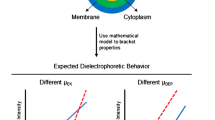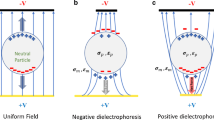Abstract
Dielectrophoresis (DEP) has been intensively studied to differentiate cells treated with heat or drugs. To estimate cell properties from DEP experiments, the multi-dimensional relationship between the electrical polarization and the electrical properties of cell components should be understood. However, the limited information extracted from DEP experiments has imposed the burden of approximation of multiple cell properties. In this paper, we present a novel sensitivity analysis to predict cell properties from DEP experimental data. We generated virtual sample cells of various properties in given ranges. Then, the experimental conditions to achieve a higher sensitivity of a polarization factor to cell properties were found through a regressive analysis. Based on the sampling results, cell properties were estimated from the experimental data using a conventional frequency method and a new transition condition method. The estimation predicts the possible properties of cells, which benefits rigorous analysis of cell properties.
Similar content being viewed by others
References
Gagnon, Z. R., “Cellular Dielectrophoresis: Applications to the Characterization, Manipulation, Separation and Patterning of Cells,” Electrophoresis, Vol. 32, No. 18, pp. 2466–2487, 2011.
Khoshmanesh, K., Nahavandi, S., Baratchi, S., Mitchell, A., and Kalantar-zadeh, K., “Dielectrophoretic Platforms for Bio-Microfluidic Systems,” Biosensors and Bioelectronics, Vol. 26, No. 5, pp. 1800–1814, 2011.
Asami, K., “Characterization of Biological Cells by Dielectric Spectroscopy,” Journal of Non-Crystalline Solids, Vol. 305, No. 1, pp. 268–277, 2002.
Broche, L. M., Bhadal, N., Lewis, M. P., Porter, S., Hughes, M. P., and Labeed, F. H., “Early Detection of Oral Cancer-Is Dielectrophoresis the Answer?” Oral Oncology, Vol. 43, No. 2, pp. 199–203, 2007.
Labeed, F. H., Coley, H. M., Thomas, H., and Hughes, M. P., “Assessment of Multidrug Resistance Reversal Using Dielectrophoresis and Flow Cytometry,” Biophysical Journal, Vol. 85, No. 3, pp. 2028–2034, 2003.
Ratanachoo, K., Gascoyne, P. R., and Ruchirawat, M., “Detection of Cellular Responses to Toxicants by Dielectrophoresis,” Biochimica et Biophysica Acta (BBA)-Biomembranes, Vol. 1564, No. 2, pp. 449–458, 2002.
Gielen, F., de Mello, A. J., and Edel, J. B., “Dielectric Cell Response in Highly Conductive Buffers,” Analytical Chemistry, Vol. 84, No. 4, pp. 1849–1853, 2012.
Park, S., Zhang, Y., Wang, T.-H., and Yang, S., “Continuous Dielectrophoretic Bacterial Separation and Concentration from Physiological Media of High Conductivity,” Lab on a Chip, Vol. 11, No. 17, pp. 2893–2900, 2011.
Castellarnau, M., Errachid, A., Madrid, C., Juarez, A., and Samitier, J., “Dielectrophoresis as a Tool to Characterize and Differentiate Isogenic Mutants of Escherichia Coli,” Biophysical Journal, Vol. 91, No. 10, pp. 3937–3945, 2006.
Gascoyne, P. R. C., Becker, F. F., and Wang, X.-B., “Numerical Analysis of the Influence of Experimental Conditions on the Accuracy of Dielectric Parameters Derived from Electrorotation Measurements,” Bioelectrochemistry and Bioenergetics, Vol. 36, No. 2, pp. 115–125, 1995.
Hasted, J. B., Ritson, D. M., and Collie, C. H., “Dielectric Properties of Aqueous Ionic Solutions. Parts I and II,” The Journal of Chemical Physics, Vol. 16, No. 1, pp. 1–21, 1948.
Alberts, B., Johnson, A., Lewis, J., Raff, M., Roberts, K., and Walter, P., “Molecular Biology of the Cell,” New York: Garland Science, 4th Ed., 2002.
Morgan, H., Sun, T., Holmes, D., Gawad, S., and Green, N. G., “Single Cell Dielectric Spectroscopy,” Journal of Physics D: Applied Physics, Vol. 40, No. 1, pp. 61–70, 2006.
Sanchis, A., Brown, A. P., Sancho, M., Martinez, G., Sebastian, J. L., et al., “Dielectric Characterization of Bacterial Cells Using Dielectrophoresis,” Bioelectromagnetics, Vol. 28, No. 5, pp. 393–401, 2007.
Fumagalli, L., Esteban-Ferrer, D., Cuervo, A., Carrascosa, J.L., and Gomila, G., “Label-Free Identification of Single Dielectric Nanoparticles and Viruses with Ultraweak Polarization Forces,” Nature Materials, Vol. 11, No. 9, pp. 808–816, 2012.
Wyman, J., “Studies on the Dielectric Constant of Protein Solutions I. Zein,” Journal of Biological Chemistry, Vol. 90, No. 2, pp. 443–476, 1931.
Kukic, P., Farrell, D., and McIntosh, L. P., “Protein Dielectric Constants Determined from NMR Chemical Shift Perturbations,” Journal of the American Chemical Society, Vol. 135, No. 45, pp. 16968–16976, 2013.
Li, L., Li, C., Zhang, Z., and Alexov, E., “On the Dielectric “Constant” of Proteins: Smooth Dielectric Function for Macromolecular Modeling and Its Implementation in Delphi,” Journal of Chemical Theory and Computation, Vol. 9, No. 4, pp. 2126–2136, 2013.
Van der Maarel, J., “Effect of Spatial Inhomogeneity in Dielectric Permittivity on DNA Double Layer Formation,” Biophysical Journal, Vol. 76, No. 5, pp. 2673–2678, 1999.
Helton, J. C., Johnson, J. D., Sallaberry, C. J., and Storlie, C. B., “Survey of Sampling-Based Methods for Uncertainty and Sensitivity Analysis,” Reliability Engineering & System Safety, Vol. 91, No. 10, pp. 1175–1209, 2006.
Saltelli, A., Chan, K., and Scott, E., “Sensitivity Analysis Wiley Series in Probability and Statistics,” Willey, New York, 2000.
Hughes, M. P., “Nanoelectromechanics in Engineering and Biology,” CRC Press, 2002.
Gascoyne, P. R. and Vykoukal, J. V., “Dielectrophoresis-Based Sample Handling in General-Purpose Programmable Diagnostic Instruments,” Proceedings of the IEEE, Vol. 92, No. 1, pp. 22–42, 2004.
Green, N. G., Ramos, A., Gonzalez, A., Morgan, H., and Castellanos, A., “Fluid Flow Induced by Nonuniform Ac Electric Fields in Electrolytes on Microelectrodes. III. Observation of Streamlines and Numerical Simulation,” Physical Review E, Vol. 66, No. 2, Paper No. 026305, 2002.
Park, S. and Beskok, A., “Alternating Current Electrokinetic Motion of Colloidal Particles on Interdigitated Microelectrodes,” Analytical Chemistry, Vol. 80, No. 8, pp. 2832–2841, 2008.
Author information
Authors and Affiliations
Corresponding author
Rights and permissions
About this article
Cite this article
Lee, HB., Jeong, M. & Chung, JH. Dielectrophoretic sensitivity analysis of cell characterization. Int. J. Precis. Eng. Manuf. 18, 747–754 (2017). https://doi.org/10.1007/s12541-017-0089-1
Received:
Revised:
Accepted:
Published:
Issue Date:
DOI: https://doi.org/10.1007/s12541-017-0089-1




